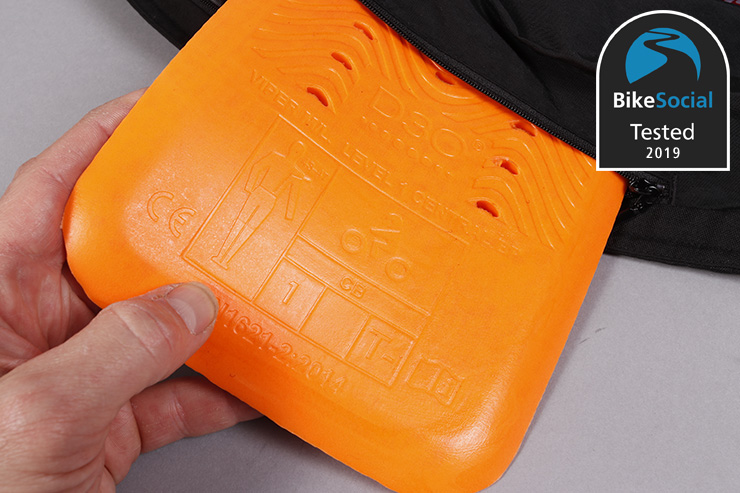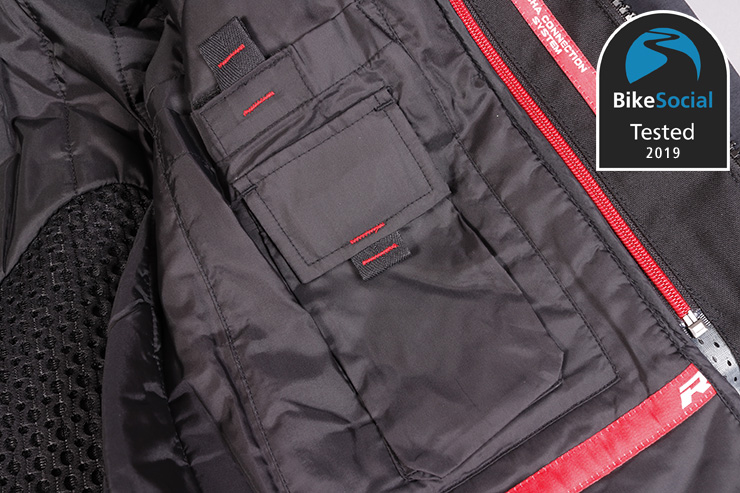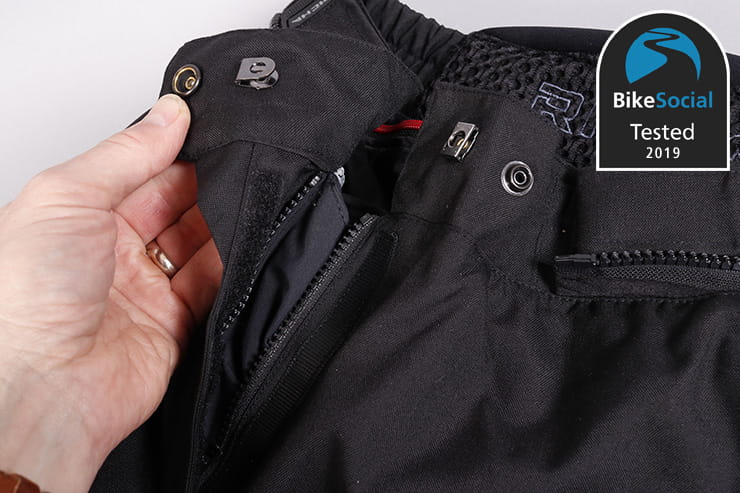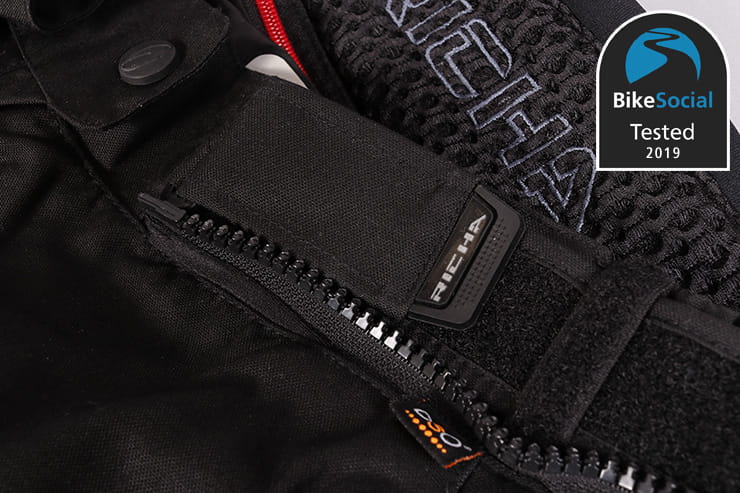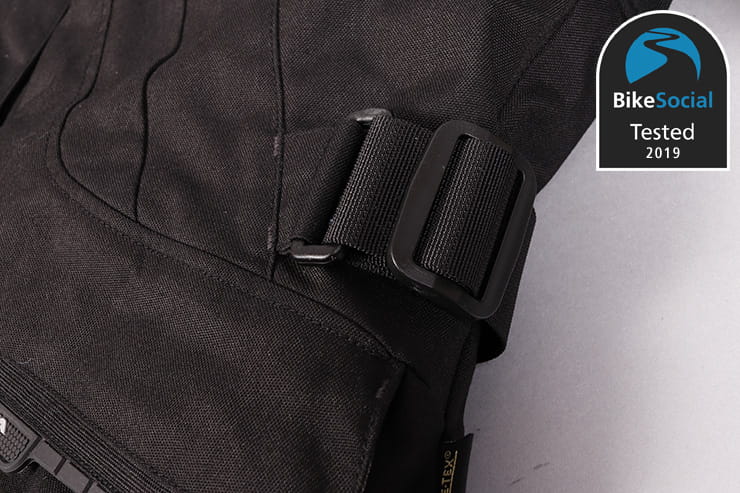Date reviewed: May 2019 | Tested by: Patricia Stiemke, BikeSocial Test Team | Price: £430 (Jacket) £330 (trousers) | www.nevis.uk.com/products/richa
Do you know that feeling when you have a favourite pair of really cheap sneakers? They’re frayed at every edge, the soles have not been waterproof since two summers ago, but they’re oh so comfortable. And then you get a brand new expensive pair that feel like they have been made for you and look great on top of it all. That was the feeling I had when I switched from my Triumph textile jacket (£34 off eBay when I started riding again), to the Richa Cyclone Ladies Textile jacket reviewed here. Not only was it a step up in quality in every sense of the word, but a lesson in what motorcycle clothing can and should be for everyone. It’s the same story with the matching Cyclone GoreTex trousers, as my previous Motero trousers had the same 30-odd quid price tag and were being held together by duct tape at the hips.
I’ve worn the Richa kit since the end of February and still managed to catch some proper winter conditions with a few days of false summer thrown in. I ride in all conditions – 70 miles a day to and from work along forested B roads, hill and dale A-roads, dual carriageways and city traffic. I also get put through my paces at the weekends with observed rides where I get chased to exhaustion through the same type of roads and in all weathers. All of this on my 1999 ZX-6R. And yes, it still runs nicely despite my amateur maintenance. I’ve managed to clock up around 3,500 miles wearing this kit, and I have not regretted a single day in it…
Fit
I consider myself an average build and size at 167cm (5’5”) and 64kg (around 10 stone), so got the Richa kit in size DL, which equates to Large. That fits me quite nicely and still lets me squeeze in the Blaze Heated Wear on days colder than 4°C, despite the thermal liner giving it a bit of a snug feel. It didn’t occur to me to take the thermal lining out while wearing the heated kit.
The design features that distinguish this as women’s kit are the extra cloth panels in the chest area of the jacket, along with the waisted tailoring. On the trousers, there are kidney-shaped foam pads on the outside of the hips. These are firmly sewn in and cannot be taken out, and can’t be considered as armour.
The jacket sleeves are the perfect length, stopping slightly past my wrist and when the zippered ventilation and end-piece is closed, it flows seamlessly over whatever gloves I’m wearing. Except my racing gloves, as they have a huge piece of stiff plastic moulding for adjusting the Velcro and cannot be tucked away. Then again, you don’t wear racing gloves if you’re expecting rain.
Another reason the arms give that ‘just right’ fit is the accordion stretch panels just above the elbow pads. Richa calls it ‘Gecko’ stretch. At the wrist there’s an extra Velcro flap that adjusts the wrist closure even further, but more on that later.
The armour pads on the back, shoulders, elbows and knees are almost innocuous. They don’t interfere or are particularly noticeable regardless of the position I adopt while riding. They also stay in place where they are supposed be. This is part of the reason why it feels like having just normal clothing on. On the trousers, the accordion stretch panels above the knee are proper working panels, unlike a few other Ladies’ trousers where they are missing or just for show (buyer beware).
Together with the zipped lower leg panels that go over the boots, the trousers stay in place with a perfect amount of stretch, but without riding up and the knee pads ending up on the thighs.
Richa also uses Cordura Spandex material, which on the trousers provides extra stretch behind the knees, over the knees, down the inside of the lower legs and as a horizontal strip running below the waistband. On the jacket these stretchy bits can be found down the outside of the lower sleeves, under the armpits and along the shoulders, top and front. It also attaches the neck closure flap to the zipper cloth cover, providing some give when the neck flap is closed.
The specifically labelled ‘Richa Connection System’ basically means that the trousers and jacket can be zipped together at the waist, beginning and ending just at the front of the hip bones. The generously wide stretch fabric attached to the jacket connection zipper also contributes to the fact that it doesn’t feel like a restrictive one-piece garment. Intriguingly, there is a much shorter central zipper at the centre of the back connecting the jacket and trousers so that holds the two garments together when walking around with an open jacket. The connection zipper on the trousers will also fit with Richa’s Atacama jacket, according to the website.
The round neoprene strip at the neck of the jacket feels lovely and smooth against the neck and presents a good amount of stretch when twisting the neck. The whole inside of the neck piece has a smooth, thick fabric lining that hugs the neck with velvety comfort.
At the small of the back is a cushioned high-waist panel, also with a neoprene rim, so there is no pressure from the panel on any of the vertebrae.
Protection and certification
The armour on the jacket and trousers is D3O – this non-Newtonian product is found in the majority of bike kit now, being pliable, twistable and therefore comfortable. The back protector has what I can only describe as gills that gives it cushioning and air flow at the same time.
As this kit is marketed for touring, and to avoid too much bulk, Richa did not fit in the highest level of protection. The shoulder, elbow, knee pads and back protector are all CE-approved to Level 1, though you can upgrade the back protector to Level 2.
As an aside, do I think reflective stripes are part of protection? Yes, I do. There are 3M ‘Reflective Zones’ on the jacket across the upper back, covering the cloth flaps over all the ventilation zippers, in the small of the back with a Richa logo, across the upper arms, down the lower arms and in two small strips down the chest area. On the trousers there are two strips down the outside of each leg. I’m glad to have this extra visibility on the winter commute.
Neither the jacket or trousers have, at the time of writing, been certified as CE approved under prEN17092
From April 21 2018, all new motorcycle clothing is deemed to be Personal Protective Equipment (PPE). To meet this legislation, it must be tested to a recognised standard. For more information on the new laws, click here.
Pockets
Unlike a majority of women’s trousers, the Richa Cyclone has a usable pocket on the left-hand side at the front. It is the only pocket, but it is deep, spacious and closes with a waterproof cloth-covered zipper. The zipper has a pull line with a small tab, making it discreet but not fiddly to open and close.
The jacket has two outer pockets and three and a half inner pockets. The inner pockets are duplicated in the thermal lining on the left and right-hand side. They close with short central Velcro strips, but for easier manipulation by a gloved hand there are decent sized pull tabs for all the pockets on the outer Velcro strips.
The reason I say a half pocket is because there’s a phone pocket on top of the main one on the left. However, unless you’re still using a Nokia 6310, a modern smart phone will not fit in there. I have an iPhone 6 and even without its case, it’s too big for the pocket. It will fit more than comfortably in the pocket behind it though. Possible uses for the small one: pens and cigars.
The outer pockets on the jacket are at waist height and have a fold-over flap with a Velcro strip. Along the outer strip runs a rubber tab ending in a slightly thicker end. There’s also a popper toward the centre of the jacket. Apart from having the rubber strip for better grip on the flap, when you open the popper and lift that end of the flap any rain will still not enter the pocket because the outer pocket cloth is cut in a curve so that you have to lift the flap completely to expose the inside. The pocket is wider than it is deep, but I do find that when rummaging around with a gloved hand, the lining tends to cling to my glove when pulling stuff out.
Despite this, the rubber tabs and the way the pocket is designed are part of a list of small details that makes this jacket justify the price.
Fastening
The main jacket zipper, along with the waist connector zippers are big YKKs. The central zipper is reinforced with four Velcro strips and three poppers running down the centre of the jacket, and has tab attached to the zipper pull. The trousers are done up with another YKK zipper and the entire length is covered with a thin Velcro strip.
There’s a cloth flap across the top at the waistband that’s closed with a popper at the end and a metal quick release hook and loop in the middle of the flap. That’s a good thing because the biggest let down in this kit is actually the poppers on the trousers and the neck flap; they’re hard to close on the trousers and the neck, and the one on the trousers does tend to pop open. And not just after I’ve eaten.
The zippers on the lower sleeves are a good length and with a pull tab, but if they’re not completely closed they will creep open while on the move.
The Velcro used is a smooth, almost rubber base with the hooks being very short and feeling smooth to the touch. This has three advantages; it tends to collect less fuzz over time, you don’t expose your skin to a rough, abrasive surface every time you need to use the fasteners, and they’re not that hard to pull apart. They do stick well enough though. Where more sticking strength is needed, Richa has simply made the strips wider.
One last clever fastening is the hook and loop on the neck closure flap. When not riding, or for more air flow, this flap can often stick against the throat and generally be a nuisance. Here it can be bent back on itself and fastened to a small plastic hook on the neck by an elastic loop at the end of the neck closure flap. Another satisfying small detail that has been dealt with nicely.
Adjustment
There are a number of small adjustments available to make these textiles fit even better, or adapt to whatever you have on underneath. There’s a series of three poppers at the bottom of the jacket, and loop and slider adjustment belts at waist height on either side. There are also Velcro loop bands on the undersides of the upper and lower arms.
At the end of the sleeves there’s another Velcro strip with flap, but instead of closing over the zipper end, it fine adjusts the wrist opening going away from the zipper. I wouldn’t recommend making major adjustments at the wrists as the cloth will fold and can create pressure points on the wrist. Also, the wrist band is reinforced cloth, making pressure even more likely. I’m not sure what Richa was thinking here.
The neck closure is not adjustable. The stretch fabric that attaches the closing flap is the only part that has a bit of give but I have had no problems with wind coming into the suit or the helmet. As a matter of fact, the first noticeable effect of wearing the jacket was that it had become quieter in my helmet. Very nice.
On the trousers, there’s accordion fabric on the sides as part of the waistband and the Velcro loop bands have a lot of room for adjustment to reduce the length. The waistband can be extended, but a word to the super hungry – it doesn’t stretch all that much.
At the bottom of the legs there is also room to tighten the leg closure by quite a bit.
Ventilation
The ventilation works and it works well; it will definitely save me from being called lobster face while riding through Sweden in the summer. The jacket has zippered ventilation panels over the shoulder bones, somewhat shorter ones over the collar bones, triangular ones at the sides of the jacket at hip level (which open by themselves a lot!) and down the lower arms, integrated in the panel behind the sleeve closure zippers.
The trousers have no ventilation panels, however in both jacket and trousers the lining is a very thin smooth material with closely-placed holes. With the ventilation panels on the jacket, the air flows freely from front to back as the panels are at the same height on the upper torso.
The Cyclone offers a breathable membrane, and although I can definitely say that the jacket and trousers let no wind through, I have never felt clammy or sweaty on the warmer days. The only caveat though is that I’ve not yet experienced temperatures higher than 22°C. That is hopefully yet to come. We have a biking trip planned as a summer holiday and that will be quite the stress test.
Warmth
Of course, there are limits beyond which only a snow suit base layer will suffice, but with a decent normal base layer that limit is at about 4°C with the Richa Cyclone. The thermal lining makes quite a difference; it’s not quilted, but the thicker sections do seem to trap a bit of air for warmth. For the really cold weather though, I still opt for my heated kit.
There are plastic poppers to connect the ends of the thermal liners to the jacket and trousers, which are colour coded. The loops to hook the small bands into in the arms and legs are black and red, as are the popper-equipped bands, so you can’t muddle them up. Attention to detail is a sign of quality in my eyes.
Liner
There are two large vertical bands on either side of the back protector made of 3D mesh for airflow, as well as in the trousers along the inside of the raised waist section.
When the jacket and trousers are zipped together, I do find that a portion of the inner thermal liner rucks up at the waist and pokes out the front. It does not interfere with closing the jacket though. The other slightly annoying bit of the liner is that when taking arms out of the lined sleeves the liner often gets caught up in whatever you’re wearing on your arms. It springs back into place, but I get nervous that this is putting undue wear and tear on the loops holding the sleeve ends of the liner in place.
It’s a similar story with the trouser liner; the placement of the attachment loops means trying to slide the lining into boots without wrinkles while getting a smooth fit of the outer trouser legs is not possible as the loops are too far down the leg to not wrinkle the lining and exert some tension on the loops.
A nicer detail about the liners are that they have bright red zippers to match the bright red zippers on the jacket and trousers. This is a nice guide for the perpetually-confused when re-attaching the liners.
Waterproofing
The GoreTex drop-liner membrane works really well through most rainy conditions as everything remains dry. The one absolute deluge I had to make my way through (twice in one day) didn’t have the same result – the jacket felt soggy on the outside and heavier than usual. This was due to the outer material ‘wetting out’. Waterproof kit with a drop-liner typically has a Durable Water Repellent (DW) coating on the outer shell – this wears with time and washing, but also has a limit to its effectiveness in heavy rain.
Once a jacket has wetted out, the waterproof membrane beneath it can’t breathe, so your sweat makes the inside feel damp. Once soaked like this, the kit didn’t dry out while I was at work, despite it being in a warm locker room all day.
The only way to really beat this is to invest in some quality (and expensive) laminated kit, which shakes dry even after very heavy rain.
Conclusion
Despite niggles about liner fastenings, poppers and the way the kit behaves in a heavy downpour, I’m thoroughly grateful to have these textiles. I have absolutely no qualms about going on a summer biking holiday with the Cyclone as I’m confident I’ll not get too hot in them; the ventilation works really well.
As far as rain is concerned, well, I shall persevere as the kit does stay dry in ‘normal rain’. I’ll also be looking forward (if that is the right expression) to wearing it through the coming winter.
The kit has worn well; apart from the little dots of dead bug remains here and there, everything looks as pristine as the day I received the clothing and neither jacket nor, more importantly, trousers have lost their shape.
This is how motorcycle clothing should be; easy, functional, comfortable and safe. These are my new comfy sneakers that will last forever…










